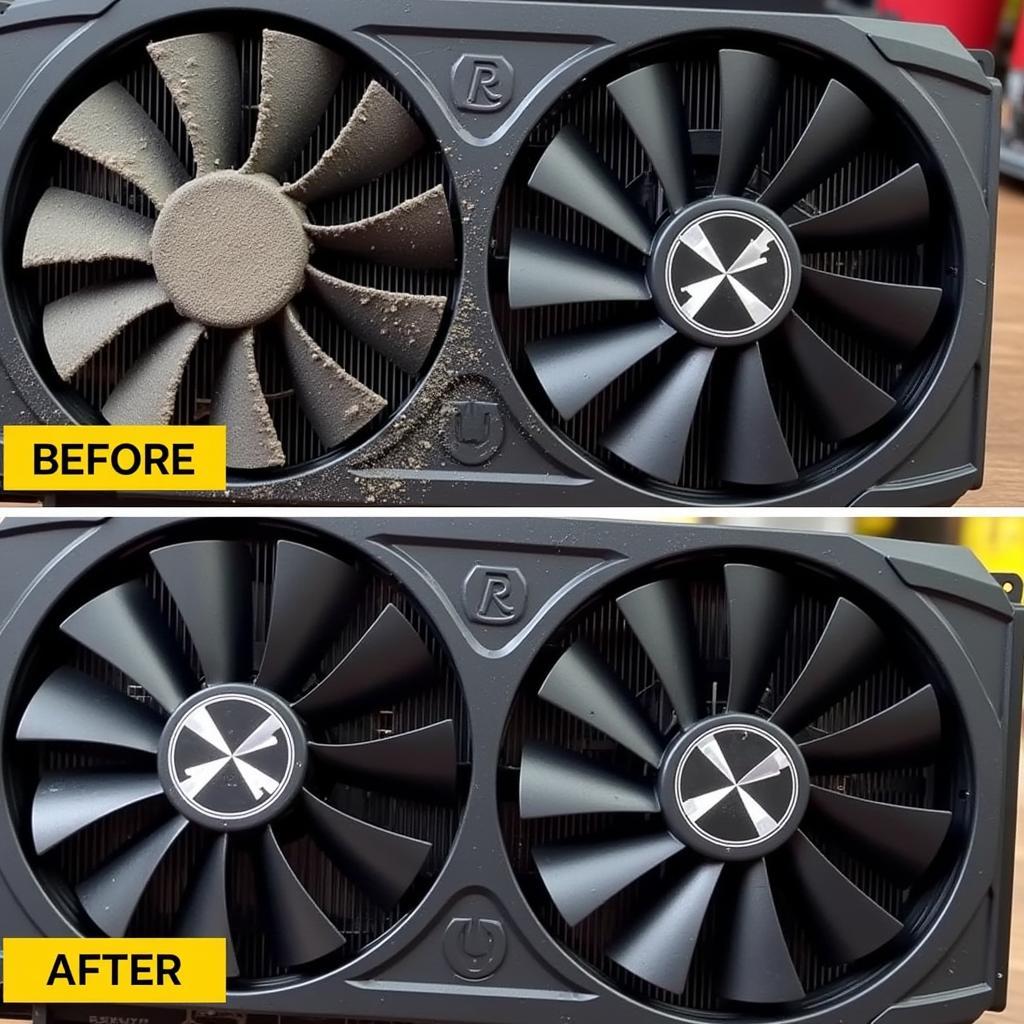Keeping your GPU cool is crucial for optimal performance and longevity. Over time, dust and debris accumulate on the GPU fan, hindering its ability to dissipate heat effectively. This build-up can lead to overheating, reduced performance, and even hardware failure. Knowing how to clean your GPU fan is a vital skill for any PC gamer or enthusiast. This guide provides a step-by-step approach to cleaning your GPU fan, ensuring your system runs smoothly and efficiently.
Cleaning your GPU fan isn’t as daunting as it sounds. With the right tools and a little patience, you can restore your GPU’s cooling efficiency and extend its lifespan. Learn more about how to maintain your fans with our guide on how to make case fans quieter.
Gathering Your Cleaning Supplies
Before you begin, gather the necessary tools. You’ll need:
- Compressed air: This is the primary tool for removing dust and debris.
- Soft-bristled brush: A small paintbrush or makeup brush works well. Avoid using hard brushes, as they can damage the fan blades.
- Cotton swabs: Useful for cleaning hard-to-reach areas.
- Isopropyl alcohol (90% or higher): For cleaning stubborn grime. Never use water.
- Screwdriver: If you need to remove the fan from the GPU.
- Anti-static wrist strap (optional but recommended): Protects your components from static electricity.
Disassembling the GPU (If Necessary)
In some cases, you may need to remove the GPU from your computer and disassemble the fan for a deeper clean. If your card is severely clogged, consider this option. Refer to your GPU manufacturer’s documentation for specific instructions on disassembly. It’s also a good idea to know about your cougar fan airflow direction for proper reassembly.
Cleaning the GPU Fan Blades
With your tools ready, you can begin cleaning. Start by using compressed air to blow away loose dust and debris from the fan blades. Hold the can upright and use short bursts of air to avoid damaging the fan. For stuck-on grime, dampen a cotton swab with isopropyl alcohol and gently wipe the fan blades.
Cleaning the Heatsink and Surrounding Area
Dust often accumulates on the heatsink and surrounding components as well. Use compressed air and a soft-bristled brush to clean these areas. Be gentle and avoid applying excessive pressure.
Reassembling and Testing
Once everything is clean, reassemble the GPU and reinstall it in your computer. Check if the fan is spinning correctly and monitor the GPU temperature during use. You should notice a significant improvement in cooling performance. You might find the guide about fan the fan failed to respond helpful in troubleshooting any issues.
Why is Cleaning Your GPU Fan Important?
Regular cleaning prevents dust build-up, ensuring optimal cooling and preventing potential damage to your GPU. A clean GPU runs cooler, performs better, and lasts longer. Consider investing in a 200mm AC fan for better case airflow.
How Often Should I Clean My GPU Fan?
Ideally, you should clean your GPU fan every 3-6 months, depending on your environment and usage. If you notice excessive fan noise or increased GPU temperatures, it might be time for a cleaning. Understanding laptop fan noise can be helpful in diagnosing potential issues.
 Clean GPU Fan Improved Performance
Clean GPU Fan Improved Performance
Conclusion
Cleaning your GPU fan is a simple yet crucial maintenance task that can significantly impact your system’s performance and longevity. By following the steps outlined in this guide, you can ensure your GPU stays cool, quiet, and runs at its best for years to come. Don’t neglect this essential task – your GPU will thank you.
FAQ
- Can I use water to clean my GPU fan? No, never use water. Always use isopropyl alcohol.
- How can I tell if my GPU is overheating? Signs of overheating include excessive fan noise, performance drops, and system crashes.
- What should I do if my GPU fan is still noisy after cleaning? Check if the fan is spinning freely and consider replacing the thermal paste.
- Do I need to disassemble my GPU every time I clean the fan? No, you usually only need to disassemble it for a deep clean.
- What is the best way to prevent dust build-up in my PC? Regular cleaning, using dust filters, and maintaining good airflow can help prevent dust accumulation.
- Can I use a vacuum cleaner to clean my GPU fan? While possible, it’s generally not recommended due to the risk of static electricity and damage to the fan.
- Is it safe to clean my GPU fan while it’s still installed in the computer? Yes, you can clean it while installed, but it might be more effective to remove it for a deeper clean.
For further assistance, contact us at Phone Number: 0903426737, Email: fansbongda@gmail.com or visit our address at Zone 9, Area 6, Gieng Day Ward, Ha Long City, Gieng Day, Ha Long, Quang Ninh, Vietnam. We have a 24/7 customer service team ready to help.


